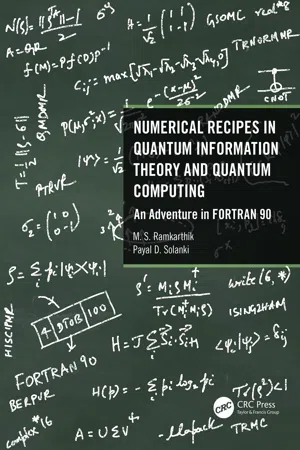
eBook - ePub
Numerical Recipes in Quantum Information Theory and Quantum Computing
An Adventure in FORTRAN 90
- 424 pages
- English
- ePUB (mobile friendly)
- Available on iOS & Android
eBook - ePub
Numerical Recipes in Quantum Information Theory and Quantum Computing
An Adventure in FORTRAN 90
About this book
This first of a kind textbook provides computational tools in Fortran 90 that are fundamental to quantum information, quantum computing, linear algebra and one dimensional spin half condensed matter systems. Over 160 subroutines are included, and the numerical recipes are aided by detailed flowcharts. Suitable for beginner and advanced readers alike, students and researchers will find this textbook to be a helpful guide and a compendium.
Key Features:
-
- Includes 160 subroutines all of which can be used either as a standalone program or integrated with any other main program without any issues.
-
- Every parameter in the input, output and execution has been provided while keeping both beginner and advanced users in mind.
-
- The output of every program is explained thoroughly with detailed examples.
-
- A detailed dependency chart is provided for every recipe.
Frequently asked questions
Yes, you can cancel anytime from the Subscription tab in your account settings on the Perlego website. Your subscription will stay active until the end of your current billing period. Learn how to cancel your subscription.
No, books cannot be downloaded as external files, such as PDFs, for use outside of Perlego. However, you can download books within the Perlego app for offline reading on mobile or tablet. Learn more here.
Perlego offers two plans: Essential and Complete
- Essential is ideal for learners and professionals who enjoy exploring a wide range of subjects. Access the Essential Library with 800,000+ trusted titles and best-sellers across business, personal growth, and the humanities. Includes unlimited reading time and Standard Read Aloud voice.
- Complete: Perfect for advanced learners and researchers needing full, unrestricted access. Unlock 1.4M+ books across hundreds of subjects, including academic and specialized titles. The Complete Plan also includes advanced features like Premium Read Aloud and Research Assistant.
We are an online textbook subscription service, where you can get access to an entire online library for less than the price of a single book per month. With over 1 million books across 1000+ topics, we’ve got you covered! Learn more here.
Look out for the read-aloud symbol on your next book to see if you can listen to it. The read-aloud tool reads text aloud for you, highlighting the text as it is being read. You can pause it, speed it up and slow it down. Learn more here.
Yes! You can use the Perlego app on both iOS or Android devices to read anytime, anywhere — even offline. Perfect for commutes or when you’re on the go.
Please note we cannot support devices running on iOS 13 and Android 7 or earlier. Learn more about using the app.
Please note we cannot support devices running on iOS 13 and Android 7 or earlier. Learn more about using the app.
Yes, you can access Numerical Recipes in Quantum Information Theory and Quantum Computing by M.S. Ramkarthik,Payal D. Solanki in PDF and/or ePUB format, as well as other popular books in Physical Sciences & Physics. We have over one million books available in our catalogue for you to explore.
Information
1
Introduction to FORTRAN 90
For those who are new to the FORTRAN [1, 2, 3] programming language this chapter will give a detailed explanation of the FORTRAN 90 language, its syntax and structure. In this chapter we give a brief introduction to the FORTRAN 90 programming language. This we feel is important because it can provide a ready reference for those who use this book. FORTRAN is an open source distribution wherein anyone is free to download and use it. FORTRAN was developed by John Backus and his team at IBM [4] in 1957 specifically designed for scientific programming. In fact, the name FORTRAN stands for FORmula TRANslation and the FORTRAN code is more mathematically readable. From then on, the language has evolved exponentially with various features being updated in every release of it. The modern version of FORTRAN has many new features in it. However, we will be adhering to FORTRAN 90 throughout this book.
In the further sections we will give a complete view of FORTRAN 90. The program is written in any of the infinite text editors available in the web market and this program file should have file extension as ‘.f90' for the compiler to recognize it. All the programs in FORTRAN start with the keyword PROGRAM and it ends with END PROGRAM. FORTRAN uses ‘implicit real(a - h, o - z)' reserves i to n as an integer by default and the complementary alphabets as real. However, if we use ‘implicit none', it allows us to define a variable of our choice. The authors feel that implicit none is better as we will have control over our variables declared and it will facilitate easy debugging, however this is purely the choice of the programmer. FORTRAN codes are case insensitive except for string literals. Also note that FORTRAN handles single and double precision with equal ease. The single precisi...
Table of contents
- Cover
- Half Title
- Title Page
- Copyright Page
- Dedication
- Contents
- Preface
- List of Figures
- Acknowledgment
- 1 Introduction to FORTRAN 90
- 2 Nuts and Bolts of Quantum Mathematics
- 3 Numerical Linear Algebra and Matrix Operations
- 4 Tools of Quantum Information Theory
- 5 Quantum Entanglement and Its Quantification
- 6 One-Dimensional Spin Chain Models in Condensed Matter Theory
- 7 Random Matrices and Random Vectors
- Dependency Chart
- Bibliography
- Subject Index